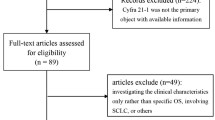Abstract
Purpose
Paclitaxel is an effective treatment for some of the non-small-cell lung cancer (NSCLC) patients. However, prediction of the outcome of paclitaxel treatment at the early stage of the chemotherapy is difficult. M30 and M65 are circulating fragments of cytokeratin 18 released during apoptosis or necrosis, respectively, and have been used as markers to evaluate chemotherapy in some cancers. Here, we aimed to examine M30 and M65 values for predicting the therapeutic outcome of paclitaxel treatment of NSCLC.
Methods
The serum levels of M30 and M65 before and after paclitaxel treatment in advance-stage NSCLC patients were analyzed, and compared to those in healthy controls. The importance of the M30 and M65 levels to the outcome of chemotherapy was analyzed.
Result
We found that the serum M30 and M65 levels were higher in patients with NSCLC (n = 44) than in control healthy subjects (n = 56) (p < 0.001). Two days after paclitaxel treatment, the serum levels of both M30 and M65 significantly increased in NSCLC patients (p < 0.001). Neither marker alone significantly correlated with overall patient survival, but the ratio of M30 vs M65 appeared to be an important prognostic factor for the overall survival of the patients (p < 0.01).
Conclusion
Our results suggest that the serum M30/M65 ratio may be a prognostic factor for the outcome of paclitaxel treatment in NSCLC.




Similar content being viewed by others
References
Caramori G, Casolari P, Cavallesco GN, Giuffre S, Adcock I, Papi A. Mechanisms involved in lung cancer development in COPD. Int J Biochem Cell Biol. 2011;43(7):1030–44. doi:10.1016/j.biocel.2010.08.022.
Buttery RC, Rintoul RC, Sethi T. Small cell lung cancer: the importance of the extracellular matrix. Int J Biochem Cell Biol. 2004;36(7):1154–60. doi:10.1016/S1357-2725(03)00261-9.
Pei J, Lou Y, Zhong R, Han B. MMP9 activation triggered by epidermal growth factor induced FoxO1 nuclear exclusion in non-small cell lung cancer. Tumour Biol. 2014;35(7):6673–8. doi:10.1007/s13277-014-1850-z.
Weaver BA. How taxol/paclitaxel kills cancer cells. Mol Biol Cell. 2014;25(18):2677–81. doi:10.1091/mbc.E14-04-0916.
Meng J, Guo F, Xu H, Liang W, Wang C, Yang XD. Combination therapy using co-encapsulated resveratrol and paclitaxel in liposomes for drug resistance reversal in breast cancer cells in vivo. Sci Rep. 2016;6:22390. doi:10.1038/srep22390.
Zhu X, Guo J, He C, Geng H, Yu G, Li J, et al. Ultrasound triggered image-guided drug delivery to inhibit vascular reconstruction via paclitaxel-loaded microbubbles. Sci Rep. 2016;6:21683. doi:10.1038/srep21683.
Zhong ZF, Tan W, Wang SP, Qiang WA, Wang YT. Anti-proliferative activity and cell cycle arrest induced by evodiamine on paclitaxel-sensitive and -resistant human ovarian cancer cells. Sci Rep. 2015;5:16415. doi:10.1038/srep16415.
Ueno T, Toi M, Linder S. Detection of epithelial cell death in the body by cytokeratin 18 measurement. Biomed Pharmacother. 2005;59(Suppl 2):S359–62.
Oyama K, Fushida S, Kinoshita J, Okamoto K, Makino I, Nakamura K, et al. Serum cytokeratin 18 as a biomarker for gastric cancer. Clin Exp Med. 2013;13(4):289–95. doi:10.1007/s10238-012-0202-9.
Dive C, Smith RA, Garner E, Ward T, George-Smith SS, Campbell F, et al. Considerations for the use of plasma cytokeratin 18 as a biomarker in pancreatic cancer. Br J Cancer. 2010;102(3):577–82. doi:10.1038/sj.bjc.6605494.
Ausch C, Buxhofer-Ausch V, Olszewski U, Schiessel R, Ogris E, Hinterberger W, et al. Circulating cytokeratin 18 fragment m65-a potential marker of malignancy in colorectal cancer patients. J Gastrointest Surg. 2009;13(11):2020–6. doi:10.1007/s11605-009-0992-6.
Ausch C, Buxhofer-Ausch V, Olszewski U, Hinterberger W, Ogris E, Schiessel R, et al. Caspase-cleaved cytokeratin 18 fragment (M30) as marker of postoperative residual tumor load in colon cancer patients. Eur J Surg Oncol. 2009;35(11):1164–8. doi:10.1016/j.ejso.2009.02.007.
Sen F, Yildiz I, Odabas H, Tambas M, Kilic L, Karadeniz A, et al. Diagnostic value of serum M30 and M65 in patients with nasopharyngeal carcinoma. Tumour Biol. 2015;36(2):1039–44. doi:10.1007/s13277-014-2708-0.
Tas F, Karabulut S, Serilmez M, Yildiz I, Sen F, Ciftci R, et al. Clinical significance of serum M30 and M65 levels in melanoma. Melanoma Res. 2013;23(5):390–5. doi:10.1097/CMR.0b013e328363e4ab.
Tas F, Karabulut S, Bilgin E, Sen F, Yildiz I, Tastekin D, et al. Clinical significance of serum M30 and M65 levels in metastatic pancreatic adenocarcinoma. Tumour Biol. 2013;34(6):3529–36. doi:10.1007/s13277-013-0931-8.
Oven-Ustaalioglu B, Bilici A, Ercan S, Orcun A, Seker M, Ozkan A, et al. Serum M30 and M65 values in patients with advanced stage non-small-cell lung cancer compared with controls. Clin Transl Oncol. 2012;14(5):356–61. doi:10.1007/s12094-012-0808-0.
Ustaalioglu BB, Bilici A, Ercan S, Seker M, Orcun A, Gumus M. The prognostic importance of changing serum M30 and M65 values after chemotherapy in patients with advanced-stage non-small-cell lung cancer. Med Oncol. 2013;30(2):551. doi:10.1007/s12032-013-0551-6.
Kramer G, Erdal H, Mertens HJ, Nap M, Mauermann J, Steiner G, et al. Differentiation between cell death modes using measurements of different soluble forms of extracellular cytokeratin 18. Cancer Res. 2004;64(5):1751–6.
Acknowledgments
This work was supported by the Chinese National Science Foundation (Grant No. 81302004), the Western Medicine Guide Project of Shanghai Committee of Science and Technology (Grant No. 16411964700), the Science and Technology Development Fund of Shanghai Chest Hospital (Grant No. 2014YZDC10101), the Shanghai Jiao Tong University Grant for Interdisciplinary Research on Medicine and Engineering (Grant No. YG2013MS12) and the Fund of Vascular Targeted therapy in Oncology of CSCO (Grant No. Y-S2015-007).
Author information
Authors and Affiliations
Corresponding authors
Ethics declarations
Conflict of interest
The authors have declared that no competing interests exist.
Informed consent
Informed consent was obtained from all individual participants included in the study. The research involved human participants. The study was approved by the Local Ethics Committee of Shanghai Chest Hospital, China.
Rights and permissions
About this article
Cite this article
Chu, T., Jiang, L., Ying, W. et al. M30/M65 ratio predicts the outcome of paclitaxel chemotherapy for NSCLC. Clin Transl Oncol 19, 326–331 (2017). https://doi.org/10.1007/s12094-016-1533-x
Received:
Accepted:
Published:
Issue Date:
DOI: https://doi.org/10.1007/s12094-016-1533-x




